
Ichthyosauria is an order of large extinct marine reptiles sometimes referred to as "ichthyosaurs," although the term is also used for wider clades that the order resides in.
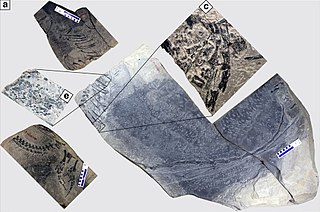
Dinocephalosaurus is a genus of long necked, aquatic protorosaur that inhabited the Triassic seas of China. The genus contains the type and only known species, D. orientalis, which was named by Li in 2003. Unlike other long-necked protorosaurs, Dinocephalosaurus convergently evolved a long neck not through elongation of individual neck vertebrae, but through the addition of neck vertebrae that each had a moderate length. As indicated by phylogenetic analyses, it belonged in a separate lineage that also included at least its closest relative Pectodens, which was named the Dinocephalosauridae in 2021. Like tanystropheids, however, Dinocephalosaurus probably used its long neck to hunt, utilizing the fang-like teeth of its jaws to ensnare prey; proposals that it employed suction feeding have not been universally accepted. It was probably a marine animal by necessity, as suggested by the poorly-ossified and paddle-like limbs which would have prevented it from going ashore.

Tanystropheus is an extinct genus of archosauromorph reptile which lived during the Triassic Period in Europe, Asia, and North America. It is recognisable by its extremely elongated neck, longer than the torso and tail combined. The neck was composed of 13 vertebrae strengthened by extensive cervical ribs. Tanystropheus is one of the most well-described non-archosauriform archosauromorphs, known from numerous fossils, including nearly complete skeletons. Some species within the genus may have reached a total length of 6 meters (20 ft), making Tanystropheus the longest non-archosauriform archosauromorph as well. Tanystropheus is the namesake of the family Tanystropheidae, a clade collecting many long-necked Triassic archosauromorphs previously described as "protorosaurs" or "prolacertiforms".
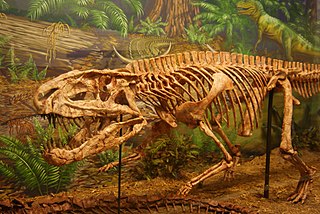
Postosuchus, meaning "Crocodile from Post", is an extinct genus of rauisuchid reptiles comprising two species, P. kirkpatricki and P. alisonae, that lived in what is now North America during the Late Triassic. Postosuchus is a member of the clade Pseudosuchia, the lineage of archosaurs that includes modern crocodilians. Its name refers to Post Quarry, a place in Texas where many fossils of the type species, P. kirkpatricki, were found. It was one of the apex predators of its area during the Triassic, larger than the small dinosaur predators of its time. It was a hunter which probably preyed on large bulky herbivores like dicynodonts and many other creatures smaller than itself.
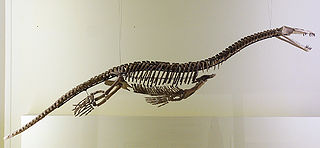
Nothosaurus is an extinct genus of sauropterygian reptile from the Triassic period, approximately 240–210 million years ago, with fossils being distributed from North Africa and Europe to China. It is the best known member of the nothosaur order.

Placodonts are an extinct order of marine reptiles that lived during the Triassic period, becoming extinct at the end of the period. They were part of Sauropterygia, the group that includes plesiosaurs. Placodonts were generally between 1 and 2 m in length, with some of the largest measuring 3 m (9.8 ft) long.

Azendohsaurus is an extinct genus of herbivorous archosauromorph reptile from roughly the late Middle to early Late Triassic Period of Morocco and Madagascar. The type species, Azendohsaurus laaroussii, was described and named by Jean-Michel Dutuit in 1972 based on partial jaw fragments and some teeth from Morocco. A second species from Madagascar, A. madagaskarensis, was first described in 2010 by John J. Flynn and colleagues from a multitude of specimens representing almost the entire skeleton. The generic name "Azendoh lizard" is for the village of Azendoh, a local village near where it was first discovered in the Atlas Mountains. It was a bulky quadruped that unlike other early archosauromorphs had a relatively short tail and robust limbs that were held in an odd mix of sprawled hind limbs and raised forelimbs. It had a long neck and a proportionately small head with remarkably sauropod-like jaws and teeth.
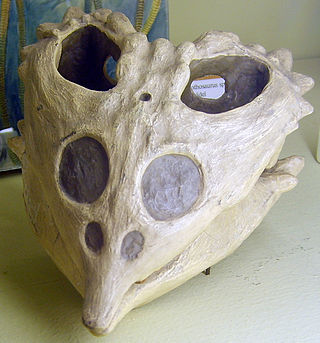
Placochelys is an extinct genus of placodont reptiles erected by Otto Jaekel in 1902.

Lariosaurus is an extinct genus of nothosaurid from the Middle Triassic of central and western Europe and China. With a complete specimen of L. xingyiensis measuring 70.5 cm (2.3 ft) long and L. hongguoensis possibly measuring up to 80 cm (2.6 ft) long, it was one of the smallest known nothosaurs. First discovered at Perledo on the Lake Como in 1830, it was named in 1847 by Curioni, its name meaning "Lizard from Larius", the ancient name of the lake. This makes it one of the earliest studied reptiles from the Alps. It is known from an almost complete skeleton holotype and several other fairly complete fossils.

Araeoscelis is an extinct genus of reptile, and potentially one of the earliest diapsids. Fossils have been found in the Nocona, Arroyo and Waggoner Ranch Formations in Texas, dating to the Early Permian. Two species have been described, A. casei and A. gracilis.

Mastodonsaurus is an extinct genus of temnospondyl amphibian from the Middle Triassic of Europe. It belongs to a Triassic group of temnospondyls called Capitosauria, characterized by their large body size and presumably aquatic lifestyles. Mastodonsaurus remains one of the largest amphibians known, and may have exceeded 6 meters in length.

Cyamodus is a genus of placodonts known from several species described from Middle-Late Triassic of Europe and China. The genus was described by Christian Erich Hermann von Meyer in 1863, based on specimens found in Germany. Like some other placodonts, Cyamodus has an armoured carapace composed of irregular hexagonal plates, with the mouth containing a small number of large, rounded teeth that were likely involved in crushing hard shelled organisms (durophagy).

Paraplacodus broilli is an extinct placodont sauropterygian from the middle Triassic period, from the Anisian until Ladinian stages. The fossils were uncovered in Northern Italy and the species was named in 1931 by Bernhard Peyer. Paraplacodus means "Almost Placodus", in reference to its similarity to Placodus.

Doswellia is an extinct genus of archosauriform from the Late Triassic of North America. It is the most notable member of the family Doswelliidae, related to the proterochampsids. Doswellia was a low and heavily built carnivore which lived during the Carnian stage of the Late Triassic. It possesses many unusual features including a wide, flattened head with narrow jaws and a box-like rib cage surrounded by many rows of bony plates. The type species Doswellia kaltenbachi was named in 1980 from fossils found within the Vinita member of the Doswell Formation in Virginia. The formation, which is found in the Taylorsville Basin, is part of the larger Newark Supergroup. Doswellia is named after Doswell, the town from which much of the taxon's remains have been found. A second species, D. sixmilensis, was described in 2012 from the Bluewater Creek Formation of the Chinle Group in New Mexico; however, this species was subsequently transferred to a separate doswelliid genus, Rugarhynchos. Bonafide Doswellia kaltenbachi fossils are also known from the Chinle Formation of Arizona.

Batrachotomus is a genus of prehistoric archosaur. Fossils of this animal have been found in southern Germany and dated from the Ladinian stage of the Middle Triassic period, around 242 to 237 million years ago. Batrachotomus was described by palaeontologist David J. Gower 22 years after its discovery.
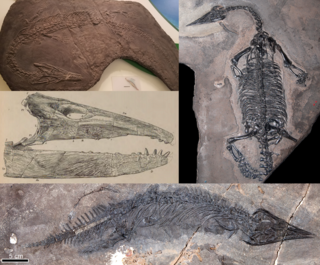
Thalattosauria is an extinct order of prehistoric marine reptiles that lived in the Middle to Late Triassic. Thalattosaurs were diverse in size and shape, and are divided into two superfamilies: Askeptosauroidea and Thalattosauroidea. Askeptosauroids were endemic to the Tethys Ocean, their fossils have been found in Europe and China, and they were likely semiaquatic fish eaters with straight snouts and decent terrestrial abilities. Thalattosauroids were more specialized for aquatic life and most had unusual downturned snouts and crushing dentition. Thalattosauroids lived along the coasts of both Panthalassa and the Tethys Ocean, and were most diverse in China and western North America. The largest species of thalattosaurs grew to over 4 meters (13 feet) in length, including a long, flattened tail utilized in underwater propulsion. Although thalattosaurs bore a superficial resemblance to lizards, their exact relationships are unresolved. They are widely accepted as diapsids, but experts have variously placed them on the reptile family tree among Lepidosauromorpha, Archosauromorpha, ichthyosaurs, and/or other marine reptiles.

Thalattoarchon is an extinct genus of large predatory ichthyosaurs that lived during the Anisian stage of the Middle Triassic in what is now North America. The only known species is T. saurophagis, described in 2013 from a single specimen discovered in the Favret Formation, Nevada. The generic name, meaning "ruler of the seas", refers to its status as an apex predator, while the specific epithet, meaning "lizard eater", alludes to its carnivorous diet.

Cartorhynchus is an extinct genus of early ichthyosauriform marine reptile that lived during the Early Triassic epoch, about 248 million years ago. The genus contains a single species, Cartorhynchus lenticarpus, named in 2014 by Ryosuke Motani and colleagues from a single nearly-complete skeleton found near Chaohu, Anhui Province, China. Along with its close relative Sclerocormus, Cartorhynchus was part of a diversification of marine reptiles that occurred suddenly during the Spathian substage, soon after the devastating Permian-Triassic extinction event, but they were subsequently driven to extinction by volcanism and sea level changes by the Middle Triassic.

Dracoraptor is a genus of coelophysoid dinosaur that lived during the Hettangian stage of the Early Jurassic Period of what is now Wales dated at 201.3 ± 0.2 million years old.

Polymorphodon is an extinct genus of archosauriform reptile from the Middle Triassic of Germany. The only known species is Polymorphodon adorfi, discovered in Lower Keuper deposits at a quarry in Eschenau, Germany. Polymorphodon is notable for its heterodont dentition, with long and conical premaxillary teeth followed by thin maxillary teeth with large serrations. Maxillary teeth near the back of the mouth are short and leaf-shaped, similar to some living and extinct reptiles with a herbivorous or omnivorous diet. This may suggest that Polymorphodon had some reliance on plants in its diet, a rarity among basal archosauriforms, most of which are carnivores.






























